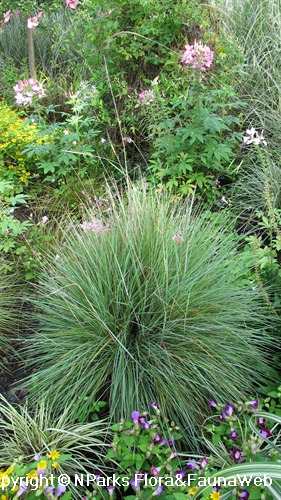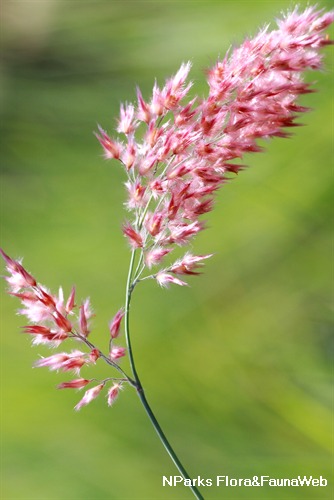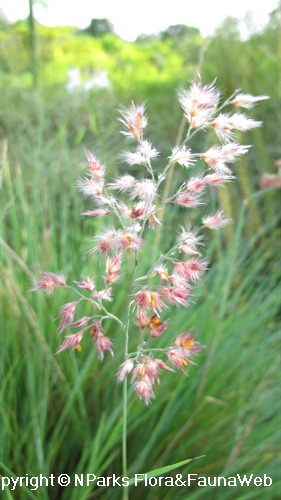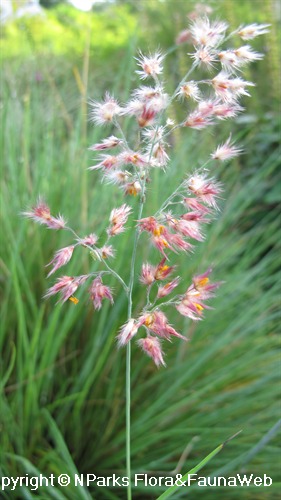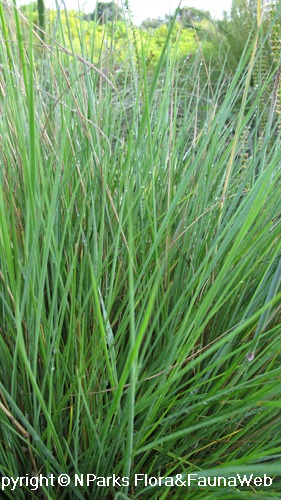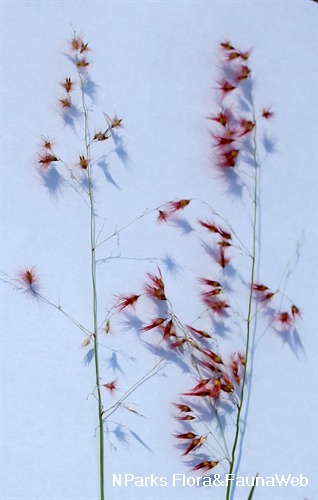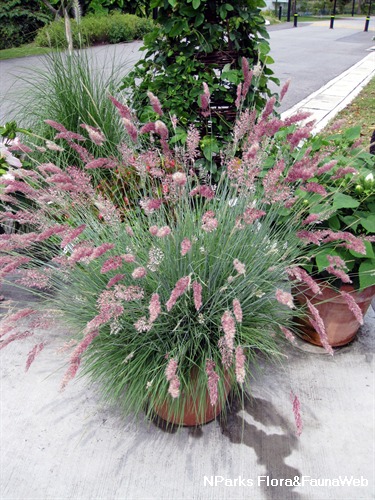
Back
Melinis nerviglumis (Franch.) Zizka
| Family Name: | Poaceae (Gramineae) |
| Synonyms: | Tricholaena rhodesiana, Acroceras nyassanum, Rhynchelytrum stuposum, Acroceras nerviglume, Rhynchelytrum setifolium, Acroceras rhodesianum |
| Common Name: | Bristle-leaved Red Top |
Name
Classifications and Characteristics
| Plant Division | Angiosperms (Flowering Seed Plants) (Monocotyledon) |
|---|---|
| Plant Growth Form | Grass or Grass-like Plant |
| Lifespan (in Singapore) | Perennial |
| Mode of Nutrition | Autotrophic |
| Maximum Height | 0.2 m to 0.5 m |
| Maximum Plant Spread / Crown Width | 0.3 m to 0.5 m |
Biogeography
| Native Distribution | Tropical Africa, Madagascar |
|---|---|
| Native Habitat | Terrestrial (Grassland / Savannah/ Scrubland) |
| Preferred Climate Zone | Tropical |
Description and Ethnobotany
| Growth Form | Perennial, clump-forming grass. |
|---|---|
| Foliage | Bluish green, rolled leaves are long and pointed (5 - 30 cm long, 2 - 3 mm wide). Leaves are soft and flexible, forming a spike-like clump. |
| Flowers | Tiny, reddish pink flowers eventually fade to a whitish colour. The branched inflorescence (known as a panicle) consists of many spikelets and is covered in soft, long hairs. They are borne on long stalks that rise above the foliage. Flowers are produced throughout the year. |
| Fruit | Dry, indehiscent fruits are known as grains. |
| Others - Plant Morphology | Propagate by seed or division of clumps. |
| Habitat | Occurs in tropical grasslands and forests at altitudes of 1000 - 2400 m. Often found on slopes with rocky soil. |
| Cultivation | This species is easy-to-grow and fast-growing. It grows best in full sun, but can tolerate partial shade. Speciments should be planted in sandy to loamy soil that is well-draining and acidic to neutral. |
| Etymology | The genus "Melinis" may be derived from the Greek word for black ("melas"), referring to the black seeds characteristic of this genus. The species epithet "nerviglumis" originated from the Latin word for nerve ("nervinus"). It refers to the venation found on the upper glumes (thin, dry bracts that are part of grass and sedge inflorescences). |
| Ethnobotanical Uses | Cut - Dried Flower: The flowers may be used fresh or dry in floral arrangements. |
Landscaping Features
| Landscaping | This ornamental grass has a fine leaf texture and long-lasting rosy flowers. It is most attractive in mass plantings. Consider using it as a mixed border or edging. |
|---|---|
| Desirable Plant Features | Ornamental Foliage, Ornamental Flowers |
| Landscape Uses | General, Flowerbed / Border, Container Planting |
Fauna, Pollination and Dispersal
| Seed or Spore Dispersal | Abiotic |
|---|
Plant Care and Propagation
| Light Preference | Full Sun, Semi-Shade |
|---|---|
| Water Preference | Moderate Water |
| Plant Growth Rate | Fast |
| Rootzone Tolerance | Easy to Grow, Drought Tolerant, Fertile Loamy Soils, Well-Drained Soils |
| Maintenance Requirements | Low |
| Propagation Method | Seed, Division |
Foliar
| Mature Foliage Colour(s) | Green |
|---|---|
| Mature Foliage Texture(s) | Smooth |
| Foliar Type | Simple / Unifoliate |
| Foliar Arrangement Along Stem | Basal |
| Foliar Shape(s) | Non-Palm Foliage (Linear) |
| Foliar Venation | Parallel |
| Foliar Margin | Entire |
| Foliar Apex - Tip | Acute |
| Foliar Base | Truncate / Square |
| Typical Foliar Area | Microphyll ( 2.25cm2 - 20.25 cm2 ) |
Floral (Angiosperm)
| Flower Colour(s) | Pink, White |
|---|---|
| Inflorescence Type | Panicle |
| Flowering Habit | Polycarpic |
| Inflorescence Size Remarks | Rosy pink fades to white at maturity. |
Fruit, Seed and Spore
| Fruit Classification | Simple Fruit |
|---|---|
| Fruit Type | Indehiscent Dry Fruit , Caryopsis / Grain |
Image Repository
Others
| Master ID | 30128 |
|---|---|
| Species ID | 4437 |
| Flora Disclaimer | The information in this website has been compiled from reliable sources, such as reference works on medicinal plants. It is not a substitute for medical advice or treatment and NParks does not purport to provide any medical advice. Readers should always consult his/her physician before using or consuming a plant for medicinal purposes. |

